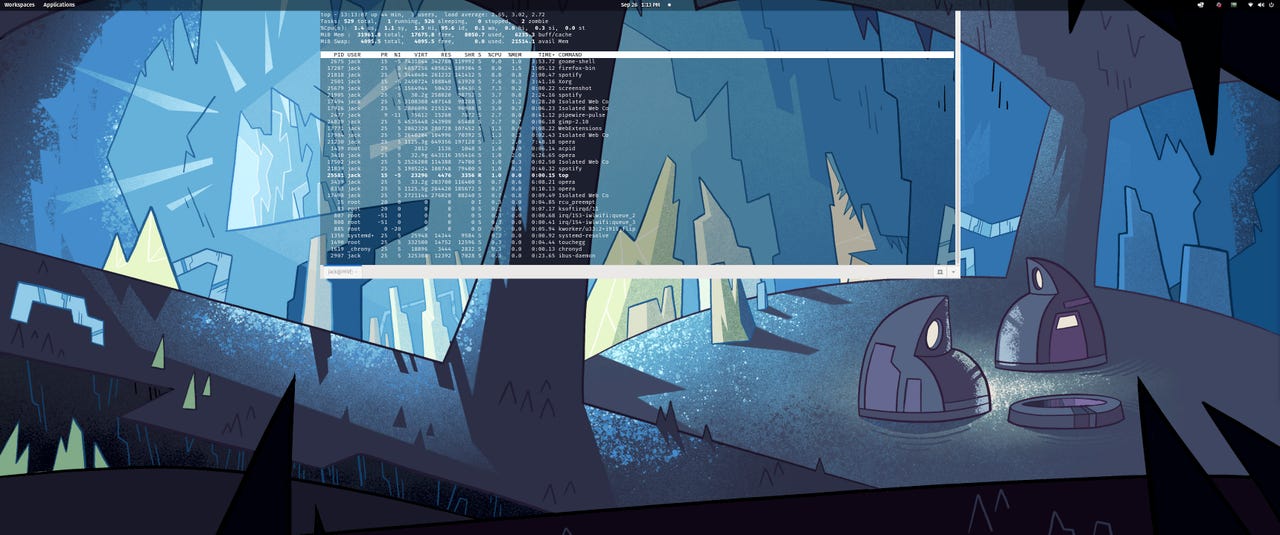































 Image: Jack Wallen
Image: Jack Wallen Not everyone likes to use the terminal on a computer. Most users wouldn't know where to begin once the terminal opens. That's because the majority of computer users were weaned on desktop environments that do not require the issuing of a single command.
But even knowing I could go my entire life never having run another command in Linux, I still tend to default to that tool. Why? It's efficient. There are times when I know exactly what I need to do and how to do it.
Most often the "how" could take one of two paths: the command line or a GUI. But knowing my fingers type faster than my hands work with a mouse or touchpad, I very often go down the CLI (Command Line Interface) path first. It's second nature to me.
Truthfully, though, for me, it's all about efficiency. So if that means a command is more efficient than tracking down the system setting in a GUI, that's the path I take.
Also: The 5 best Linux distros for programming
But that doesn't always mean the default terminal window is the most efficient option. For that, I still have to move my hand from the keyboard, maneuver my cursor to the desktop menu or a panel, and open the terminal before I can type that first command.
What if there were a more efficient option?
There is.
Said option comes in the form of the top-down terminal in Linux and it's an absolute treat to use.
Here's how a top-down terminal works:
The important thing is that your fingers never had to leave the keyboard. That's efficiency. When you're super busy throughout the day, even those collected seconds make a difference.
There are two primary top-down terminals I use: Guake and Yakuake. Guake is the top-down terminal for GNOME and Yakuake is the top-down terminal for KDE Plasma. Neither of these terminals is installed by default, so you have to add them yourself. On Ubuntu-based systems those terminals can be installed with the commands:
sudo apt-get install guake -ysudo apt-get install yakuake -y
On RHEL-based systems, those terminals are installed with:
sudo dnf install guake -ysudo dnf install yakuake -y
I'll demonstrate using a top-down terminal by way of Guake.
Also:Red Hat Enterprise Linux 9: Security baked in
When you install Guake, you'll need to open the configuration window, which is done using the command:
guake -p
In that window, you can configure quite a bit (including the look and feel of the terminal app). Most important, however, is that you want to make sure Start Guake at login is enabled. If you don't do that, you'll have to start Guake from the terminal window before you can use it upon logging into your desktop.
Configuring Guake to run at login.
Image: Jack WallenClose the preferences window and then log out of your desktop. Once you log back in, Guake will be running in the background and ready to be called up for use.
To open Guake, hit the F12 key on your keyboard to reveal the terminal. Use the terminal as you normally would and, once you've finished, hit F12 to dismiss the terminal.
Also:How to run websites as apps with ease on Linux
And that's how and why I make use of a top-down terminal in Linux. Not only is it more efficient, it removes clutter (by not using up precious space in a dock), and is also pretty cool to use. Give either Guake or Yakuake a try and see if it doesn't help make using the Linux terminal a bit more efficient and fun.
 Hot Tags :
Services & Software
Open Source
Hot Tags :
Services & Software
Open Source